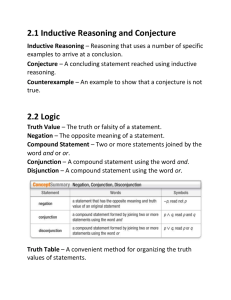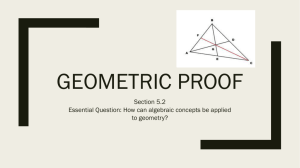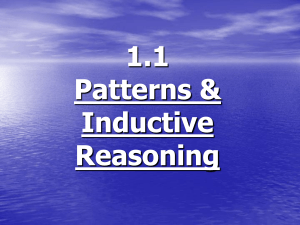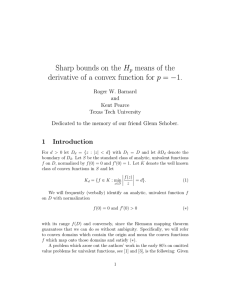A Short Proof of a Conjecture on the Integral
advertisement
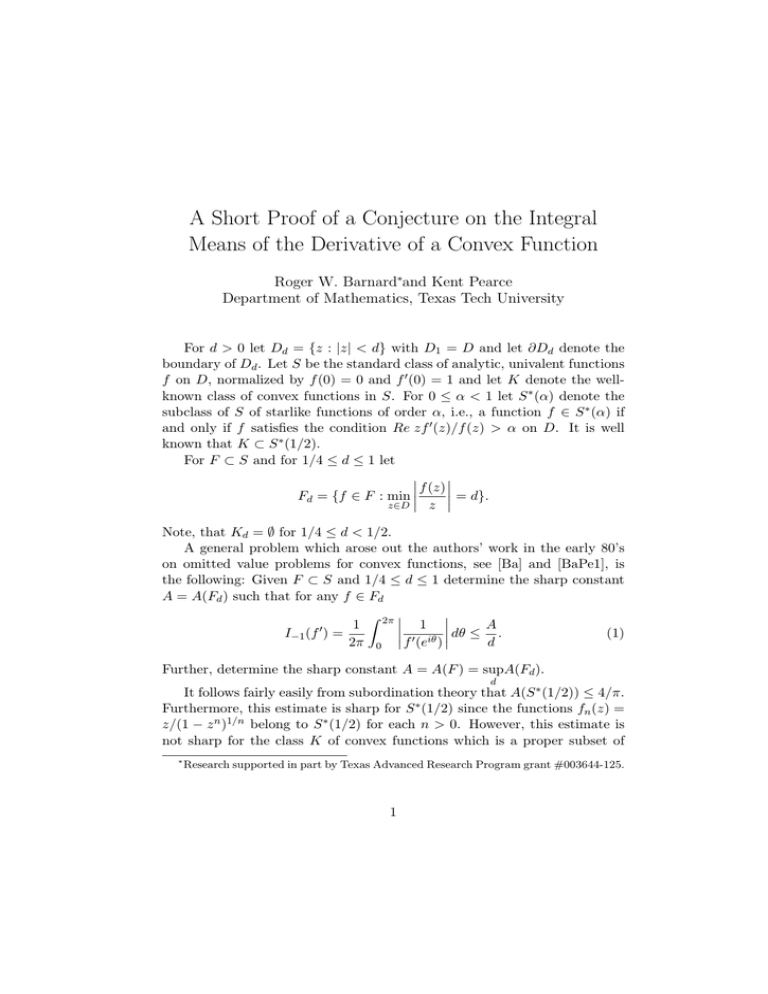
A Short Proof of a Conjecture on the Integral
Means of the Derivative of a Convex Function
Roger W. Barnard∗and Kent Pearce
Department of Mathematics, Texas Tech University
For d > 0 let Dd = {z : |z| < d} with D1 = D and let ∂Dd denote the
boundary of Dd . Let S be the standard class of analytic, univalent functions
f on D, normalized by f (0) = 0 and f 0 (0) = 1 and let K denote the wellknown class of convex functions in S. For 0 ≤ α < 1 let S ∗ (α) denote the
subclass of S of starlike functions of order α, i.e., a function f ∈ S ∗ (α) if
and only if f satisfies the condition Re zf 0 (z)/f (z) > α on D. It is well
known that K ⊂ S ∗ (1/2).
For F ⊂ S and for 1/4 ≤ d ≤ 1 let
f (z) = d}.
Fd = {f ∈ F : min z∈D
z Note, that Kd = ∅ for 1/4 ≤ d < 1/2.
A general problem which arose out the authors’ work in the early 80’s
on omitted value problems for convex functions, see [Ba] and [BaPe1], is
the following: Given F ⊂ S and 1/4 ≤ d ≤ 1 determine the sharp constant
A = A(Fd ) such that for any f ∈ Fd
Z 2π 1 1
dθ ≤ A .
I−1 (f 0 ) =
(1)
2π 0 f 0 (eiθ ) d
Further, determine the sharp constant A = A(F ) = supA(Fd ).
d
It follows fairly easily from subordination theory that A(S ∗ (1/2)) ≤ 4/π.
Furthermore, this estimate is sharp for S ∗ (1/2) since the functions fn (z) =
z/(1 − z n )1/n belong to S ∗ (1/2) for each n > 0. However, this estimate is
not sharp for the class K of convex functions which is a proper subset of
∗
Research supported in part by Texas Advanced Research Program grant #003644-125.
1
S ∗ (1/2). Considerable numerical evidence suggested to the authors to make
the following conjecture.
Conjecture. For each d, 1/2 ≤ d ≤ 1, A = A(Kd ) = 1 in (1) with
equality holding for all domains which are bounded by regular polygons
centered at the origin.
This conjecture was announced in March 1985 at the Symposium on the
Occasion of the Proof of the Bieberbach Conjecture at Purdue University.
It also appeared as Conjecture 8 in the first author’s “Open Problems and
Conjectures in Complex Analysis” in [Ba]. It was thought, by many function theorists, that the conjecture would be easily settled, given the vast
literature on convex functions and the large research base for determining
integral mean estimates, see [Du].
An initial difficulty was the non-applicability of Baerenstein’s circular
symmetrization methods, since convexity, unlike univalence and starlikeness, is not preserved under circular symmetrization. Although Steiner
symmetrization does preserve convexity, see [Va], it did not appear to be
helpful for the problem and, indeed, we found that extremal domains need
possess no standard symmetry.
A confusing issue, which also arises, is that the integral means of the
standard approximating functions fn in K defined by
fn0 (z) =
n
Y
(1 − zeiθk )−2αk , 0 < αk ≤ 1,
k=1
n
X
αk = 1
k=1
decrease when the arbitrarily distributed θk are replaced by uniformly distributed tk = kπ/n, as was shown in [Zh]. The conjecture suggests that
multiplication by the minimum modulus d must overcome this decrease.
We make the following definition.
Definition. Let Γ be a curve in C such that the left- and right-hand
tangents to the curve Γ exist at each point on Γ. The curve Γ will be said
to circumscribe a circle C if the left- and right-hand tangents to the curve
Γ at each point on Γ lie on tangent lines to the circle C.
We will employ the following notation.
Notation. Let f ∈ S and suppose that γ is a subarc of ∂D on which f
zf 0 (z)
is smooth. For z = eiθ ∈ γ let dθ =< f (z), |zf
0 (z)| >, i.e, dθ is the directed
length of the projection of f (z) onto the outward unit normal to ∂f (D) at
f (z).
In 1993 [BaPe2], we proved the following theorem which verified the
conjecture.
2
Theorem A. Let f ∈ K, d = min|f (eiθ )| and d∗ = sup dθ . Then,
θ
1
1
≤
d∗
2π
θ
2π
Z
1
1
dθ ≤
d
|f 0 (eiθ )|
0
(2)
with equality holding if ∂f (D) circumscribes ∂Dd .
The original proof, which was lengthy, was based on the Julia variational
formula and depended heavily on the convexity of f . We obtained, arising
out of the proof, the rather unexpected sufficient condition for equality to
occur in (2) for the classes Kd . However, because the proof used a scheme
to approximate convex functions by polygonally convex functions, we did
not obtain a necessary condition for equality.
We have devised a new, simpler proof for the conjecture which extends
Theorem A. The proof releases the convexity requirement and validates the
necessity of the sufficient condition.
Theorem B. Let f ∈ S ∗ (α) for some α > 0. Suppose f is smooth on
X ⊂ ∂D where X is a countable union of pairwise disjoint subarcs of ∂D
such that the complement of X in ∂D has measure zero. Let d∗ = inf dθ ,
θ∈X
d∗ = sup dθ . Then,
θ∈X
1
1
≤
∗
d
2π
Z
0
2π
1
|f 0 (eiθ )|
dθ ≤
1
d∗
(3)
with equality holding if and only if ∂f (D) circumscribes ∂Dd∗ .
f (z)
Remark. In general d∗ ≤ d = min |
| with equality if f ∈ K.
z∈D
z
S∞
Proof. Let X = k=1 γk , where each γk is a subarc of ∂D. We have
from the Cauchy Integral Formula, with z = eiθ , that
Z 2π
1
f (rz)
1 = lim
dθ
r→1 2π 0
rzf 0 (rz)
1
=
2π
Z
1
=
2π
Z
2π
Re
0
2π
f (z)
dθ
zf 0 (z)
|f (z)| cos(arg zff (z)
0 (z) )
|zf 0 (z)|
0
0
dθ
zf (z)
∞ Z
< f (z), |zf
0 (z)| >
1 X
=
dθ
0
2π
|f (z)|
γk
k=1
3
(4)
∞ Z
1 X
dθ
=
dθ
0
2π
γk |f (z)|
k=1
The restriction of f to S ∗ (α) with α > 0 assures the passage of the limit
in (4). Replacing dθ by d∗ and d∗ in this last integral gives the left- and
right-hand inequalities in (3), respectively. Equality clearly occurs if ∂f (D)
circumscribes ∂Dd∗ , for in this case d∗ = dθ = d∗ on X. Conversely, if
∂f (D) does not circumscribe ∂Dd∗ , then there must exist a subarc I, which
must lie in one of the γk , of positive (linear) measure on which
d∗ < dθ < d∗ .
(5)
The strictness of (5) on I implies that strict inequality holds in both the
left- and right-hand inequalities in (3). The authors would like to thank Al Baerenstein for his helpful suggestion
which led to their shorten proof.
References
[Ba] Barnard, R.W. “Open problems and conjectures in complex analysis”,
in Computational Methods and Function Theory, Lecture Notes in Math.
No. 1435 (Springer-Verlag, 1990), 1–26.
[BaPe1] Barnard, R.W. and Pearce, K. “Rounding corners of gearlike domains and the omitted area problem”, J. Comput. Appl. Math. 14
(1986), 217–226.
[BaPe2] Barnard, R.W. and Pearce, K. “Sharp bounds on the Hp means of
the derivative of a convex function for p = −1”, Complex Analysis 21
(1993), 149–158.
[Du] Duren, P. Univalent Functions, Springer-Verlag, New York, 1980.
[Va] Valentine, F.A. Convex Sets, McGraw-Hill, New York, 1964.
[Zh] Zheng, J. “Some extremal problems involving n points on the unit
circle”, Dissertation, Washington University (St. Louis), 1991.
4

